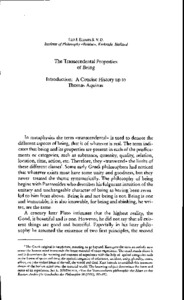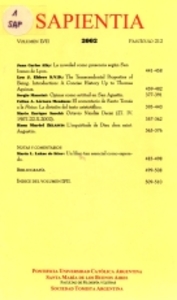Por favor, use este identificador para citar o enlazar este ítem:
https://repositorio.uca.edu.ar/handle/123456789/12577| Título: | The Transcendental properties of being | Autor: | Elders, Leo J. | Palabras clave: | SER; ONTOLOGIA; METAFISICA | Fecha de publicación: | 2003 | Editorial: | Pontificia Universidad Católica Argentina. Facultad de Filosofía y Letras | Cita: | Elders, L. J. The Transcendental properties of being [en línea]. Sapientia. 2003, 57 (212). Disponible en: https://repositorio.uca.edu.ar/handle/123456789/12577 | Resumen: | In metaphysics the term «transcendental» is used to denote the different aspects of being, that is of whatever is real. The term indicates that being and its properties are present in each of the predicaments or categories, such as substance, quantity, quality, relation, location, time, action, etc. Therefore, they «transcend» the limits of these different classesl. Some early Greek philosophers had noticed that whatever exists must have some unity and goodness, but they never treated the theme systematically. The philosophy of being begins with Parmenides who describes his fulgurant intuition of the unitary and unchangeable character of being as having been revealed to him from aboye. Being is and not-being is not. Being is one and immutable; it is also knowable, for being and thinking, he writes, are the same. A century later Plato intimates that the highest reality, the Good, is beautiful and is one. However, he did not say that all existent things are good and beautiful... | URI: | https://repositorio.uca.edu.ar/handle/123456789/12577 | ISSN: | 0036-4703 | Disciplina: | FILOSOFIA | Derechos: | Acceso abierto | Fuente: | Sapientia Vol. 57, No. 212, 2003 |
| Aparece en las colecciones: | SAP - 2003 Vol LVII nro. 212 |
Ficheros en este ítem:
| Fichero | Descripción | Tamaño | Formato | |
|---|---|---|---|---|
| trascendental-properties-being.pdf | 323,57 kB | Adobe PDF |  Visualizar/Abrir | |
| cover.jpg | 23,1 kB | JPEG |  Visualizar/Abrir |
Visualizaciones de página(s)
78
comprobado en 27-abr-2024
Descarga(s)
3.766
comprobado en 27-abr-2024
Google ScholarTM
Ver en Google Scholar
Este ítem está sujeto a una Licencia Creative Commons

